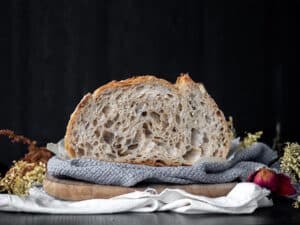Therefore, the smell, the aromas, the flavours and the texture of a bakery product are all key criteria for the customer conspiring together to define taste. These criteria naturally form the focus of the consumer’s, but also the baker’s, considerations.
All consumers need reassurances and benchmarks. For this reason, bakers must discover the secret to whetting the customer’s appetite and opening up the way to new sensations fuelled by their inspiration. The image conveyed by the product and the typicity and flavour of the loaf are inextricably linked.
Taste, typicity, and naturalness are all values that sourdough can contribute to many breadmaking and pastry making applications. Until the 17th century, all bread was made with sourdough. This only serves to illustrate the reassuring image of naturalness that it conveyed. It was used to produce bread in a different way from that involving yeast (Saccharomyces cerevisiae). Sourdough is, in effect, characterized by a combination of yeasts and bacteria, whose effects vary depending on their fermentation activity. Depending on the bacterial flora profile, aromas develop during the different fermentation stages and result in an acidic typicity dominated by lactic or acetic notes.
When bakers use sourdough to seed a dough, the bread obtained thereby is substantial, rich in flavour and slightly sour. Moreover, acidification helps improve the storage life of a product. It has a taste well-loved by aficionados.
Bread and pastries made with sourdough allow bakers to offer their customers quality products that stand out from the less tasty alternatives on offer. They lend a positive image to the profession and evoke values of authenticity, which conjure up traditional associations with the product in the consumer’s mind. The products are highly appealing for the consumer in terms of colour and appearance. The typical aroma and characteristic sour taste reflect a tendency currently observed in the food buying habits of consumers, who are increasingly in search of “traditional”, “natural” products.
Working with a leavened dough is different from working with a yeast-fermented dough. While proofing is weaker and slower at the start of baking, the crumb texture presents characteristically irregular air-holes, which lend the product a traditional appearance. The crust is thicker and the crumb dries out less quickly, thus retaining good elasticity. Bread made from sourdough gives an impression of freshness on the palate.
Each type of yeast or bacteria contributes specific aromatic notes to bakery goods depending on their respective metabolism activities. Finally, the aroma of a loaf comprises over 200 molecules. With like-for-like ingredients, depending on the fermentation factors (time, temperature, etc…), the aromatic profile can vary enormously. The different blends of complex flavours, unique for each type of bread, are hallmark “signatures” in the breadmaking process and markers of the baker’s know-how and creativity. The latter will bring his talent to bear by correcting any potential faults observed in the leavened dough production process: over-acidity or under-acidity, overly aggressive taste, or weak flavour, flat-looking appearance indicating a weak sourdough, etc…




